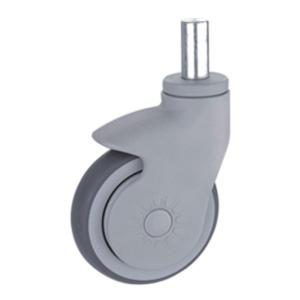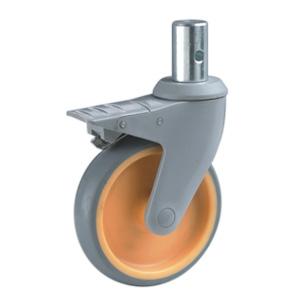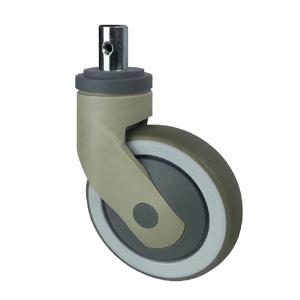What is a source of frustration for many hospitals? It is the wheel caster, its presence is announced before it comes into view, and it negatively impacts HCAHPS scores, causes staff injuries, increases maintenance expenses, and leaves floors in an unsightly condition.
Your hospital casters.
If you take a closer look at the bottom of laundry carts, IV poles, mobile workstations, dietary carts, and food service carts in hospitals, you’ll often find inexpensive, generic casters that have a negative impact on patient satisfaction scores and increase operational costs. These commodity casters bring about several challenges for hospitals. Let’s explore the top four issues and the most effective ways to tackle them.

Pain 1: Increased Noise
At the forefront of these challenges is noise, as it consistently ranks as the primary complaint among patients, staff, and visitors in annual surveys conducted by the Hospital Consumer Assessment of Healthcare Providers and Systems (HCAHPS). Year after year, excessive noise remains a significant concern that needs to be addressed.
Hospital casters are noisy for three primary reasons.
One of the key issues is the use of incorrect tread materials for caster wheels. When caster wheels are made from hard materials, they tend to generate excessive noise. For instance, hard rubber is not designed to absorb and distribute impact effectively. While it may be suitable for carts used in noisy manufacturing environments, it is unsuitable for hospitals and healthcare facilities as it creates significant noise when rolling.
Another significant issue is loose raceways in caster wheels. The raceway, which enables the caster to swivel, usually contains ball bearings or rollers for rotation. However, in many carts, workstations, and poles used in hospitals today, the caster raceways are too loose, resulting in the familiar chattering noise often associated with casters.
Additionally, a common observation in hospital equipment is the absence of wheel bearings in most caster wheels. Instead, these wheels feature a metal axle that grinds against the plastic core as the wheel rotates, causing noise.

Pain 2: Worker Injuries
Physical overexertion stands as the primary cause of workplace injuries, contributing to 35% of all work-related injuries and being a significant factor in workers’ compensation costs. Among these injuries, back injuries alone account for nearly 20% of workplace incidents and illnesses. The cost associated with a typical back injury ranges from $62,000 to $81,000 per occurrence. Addressing and preventing physical overexertion is crucial to reducing both the frequency of injuries and the financial burden on organizations.
Plenty of these workplace injuries are caused by carts that are difficult to push, pull, steer and stop. The root cause of the problem? Cheap, commodity casters that have high rolling resistance. Many casters on hospital carts do not have bearings, making them harder to move, especially when overloaded. They also commonly have standard swivel leads, which makes them harder to maneuver.
Pain 3: Costly Maintenance
Most hospital carts are equipped with commodity casters that are not designed to be maintenance-free. These casters demand regular greasing through a zerk fitting to prevent seizing, which can be time-consuming. Additionally, some of these casters have design flaws that allow debris to accumulate in the upper bearing and upper raceways, leading to caster damage and necessitating frequent servicing. It is important to address these maintenance challenges associated with commodity casters to ensure their optimal performance and longevity in hospital settings.
Pain 4: Damaged Floors
The final key pain that hospitals suffer from commodity casters is marked and damaged floors. Caster wheels with rubber treads can mark floors, particularly when they are left stationary in one place for extended periods and mopped around by cleaning staff.
Another problem for hospital floors is caster wheels that are too hard. Wheels made of nylon, for example, don’t mark floors, but they collect debris off the floor. This debris eventually hardens into the wheel’s tread, denting and dimpling hospital floors with every rotation.

What To Look For in A Hospital Caster
The cure for these top-four pains caused by commodity hospital casters is better, hospital-designed casters. If your casters are too noisy, hard to move or costly to maintain, or if they are damaging your floors, look for the following qualities in your replacement casters.
High-quality wheel material such as polyurethane: These wheels store and exude energy to reduce noise-causing vibrations, and deliver a smooth and quiet ride.
Wheels with a debris-rejecting quality: Wheels made from durable polyurethane are soft enough to be quiet but hard enough that the tread doesn’t mark floors or retain debris.
Long swivel lead: These make carts much easier to push, pull, turn, maneuver into place and stop.
Bearings: Casters with bearings are quieter, easier to maneuver and last longer.
Shop Medical Casters Here
Benefits Of Using Better Hospital Casters
Once you replace the cheap, commodity casters on your hospital carts, mobile workstations and IV poles, you’ll start seeing some noticeable improvements throughout your facility.
By addressing the issues with casters, you can expect to experience several positive outcomes. Firstly, noise levels caused by casters will significantly decrease, creating a quieter environment. Your staff will notice that equipment becomes up to 50% easier to push and pull, reducing physical strain and improving efficiency. As a result, your floor maintenance costs will decrease since less time and resources will be required to remove marks and repair damaged floors caused by problematic casters. Lastly, improved caster performance can lead to enhanced patient satisfaction, as evidenced by improved HCAHPS scores.
CONCLUSION
Your hospital can’t treat patients until your staff first diagnose their ailments. Diagnosis always precedes cure. If you’ve read this far, you now know the top-four pains that you are likely experiencing because of commodity casters in your hospital. Now you are in a position to prescribe a cure.
Incidentally, your cure can start today with a complimentary consultation with the team at Caster Connection. We take a consultative approach to solving the problems caused by inferior casters. Book your free consultation today by calling toll-free (800) 544-8978, or by dropping us a line.

